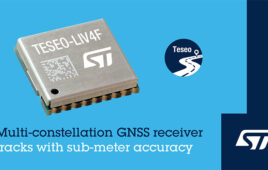The STMicroelectronics Teseo-LIV4F GNSS module leverages ST’s Teseo IV single-die receiver technology, including L1 and L5 frequency-band support, to provide positioning accuracy better than one meter in embedded geolocation systems. With an ultra-compact form factor and low power consumption, Teseo-LIV4F also extends multi-constellation compatibility to include navigation with Indian constellation (NavIC or IRNSS, the Indian…
Renesas releases new programmable clock generator
Renesas Electronics Corporation, a supplier of advanced semiconductor solutions, has introduced the VersaClock 7 clock generators, a family of configurable clock generators with an internal crystal oscillator for PCIe and networking applications in high-end computing, wired infrastructure, and data center equipment. The VersaClock 7 delivers unmatched flexibility, enabling designers to configure frequencies, Input/Output (I/O) levels,…
Insight: The internal working of a remote control
The Oxford Dictionary defines a remote control to be a “control of a machine or apparatus from a distance by means of radio or infrared signals transmitted from a device”. So, when we decided to go inside a conventional remote control, we were stuck: which one to take? There are those for LCD TV, others for gaming consoles, for the car entertainment systems and some that work for all kinds of systems. At the very first sight, one can notice difference in designs, features, the manner they are powered and several such features. But upon giving a slight thought, it is easy to understand that all the remotes are performing the same basic task: controlling outputs of an electric/electronic device. So, here we are, with a Sony RMGA020 LCD TV Remote used for their 32 inch KL television series. Interestingly, Sony calls their remote to be “Remote Commanders”. Since the trend nowadays is to equip remotes with a hoard of features and create the main gadget as simple as possible, calling them “Remote Commanders” is fair enough.
Insight – How crystal oscillators and resonators work
A quartz crystal resonator plays a vital role in electronics oscillator circuitry. Sometimes mispronounced as crystal oscillator, it is rather a very important part of the feedback network of the oscillator circuitry. Electronics oscillators are used in frequency control application finding their usage in almost every industry ranging from small chips to aerospace.The basic phenomenon behind working of a quartz crystal oscillator is the inverse piezo electric effect i.e., when electric field is applied across certain materials they start producing mechanical deformation. These mechanical deformation/movements are dependent on the elementary structure of the quartz crystal. Quartz is one of the naturally occurring materials which show the phenomena of piezo electricity, however for the purpose of resonator it is artificially developed since processing the naturally occurring quartz is difficult and costly process.




